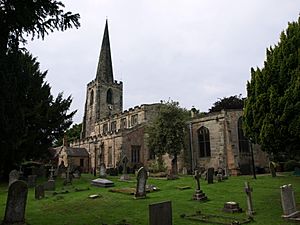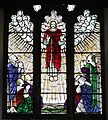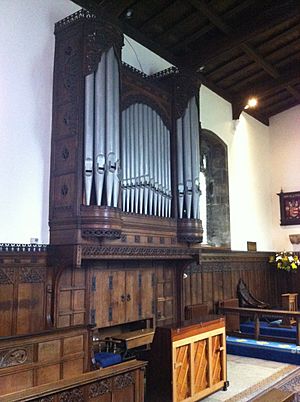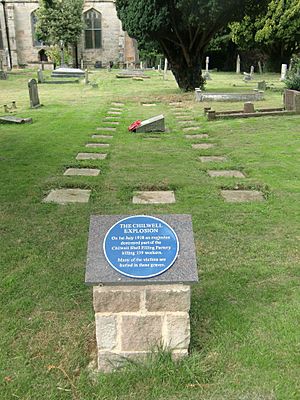St Mary's Church, Attenborough facts for kids
Quick facts for kids St. Mary's Church, Attenborough |
|
|---|---|

St. Mary's Church, Attenborough
|
|
| 52°54′14.04″N 1°13′49.8″W / 52.9039000°N 1.230500°W | |
| Location | Attenborough |
| Country | England |
| Denomination | Church of England |
| Churchmanship | Evangelical |
| History | |
| Dedication | Saint Mary |
| Specifications | |
| Height | 130 feet (40 m) |
| Bells | 8 |
| Tenor bell weight | 11cwt - 0qr - 21lb (1253lb or 568kg) in F# (754.0Hz) |
| Administration | |
| Parish | Attenborough |
| Deanery | Nottingham South |
| Archdeaconry | Nottingham |
| Diocese | Southwell and Nottingham |
| Province | York |
St. Mary's Church, Attenborough is a historic church in the village of Attenborough, Nottinghamshire. It belongs to the Church of England.
This church is very important for its architecture and history. It is listed as a Grade I building by the government. This means it is considered a building of outstanding national interest.
Contents
History of St. Mary's Church
The church building you see today has parts from the Middle Ages. These include the main body of the church (called the nave) and the area near the altar (called the chancel). It also has side sections (aisles) and a tall tower with a spire. Some newer parts were added in the 20th century. The church is surrounded by a traditional churchyard with walls and gates.
People believe a small chapel was here as early as 964 AD. The stone chancel of the current church was built over it. Records from 1086, like the Domesday Book, mention this church. It was shared by the nearby villages of Chilwell and Toton. These villages grew further away because the church was built on a gravel ridge near the River Trent. This spot had little space for homes and was prone to flooding. For many years, the churchyard was even divided by the boundary of these two villages.
The church's tall spire was rebuilt in 1848. It reaches about 40 meters (130 feet) high. In 1869, the church was restored by an architect named Richard Charles Sutton. During this work, a gallery at the west end was removed.
How the Church Parish Changed
For a long time, Attenborough was the main church for Chilwell and Toton. Even Bramcote was once part of Attenborough's parish. This large area was sometimes called "Attenborough cum Bramcote."
Over time, as more people moved into the area, new churches were built.
- In 1903, Christ Church was built in Chilwell.
- In 1923, St Peter's Church was built in Toton.
- In 1957, St. Barnabas Church was built in Inham Nook, a growing part of Chilwell.
These new churches led to changes in the parish boundaries.
- In 1967, Bramcote became its own separate parish.
- In 1975, Chilwell became its own parish, called Chilwell with Inham Nook.
- At the same time in 1975, Attenborough became Attenborough with Toton. A small part of the old parish south of the River Trent was moved to Clifton.
Because the population kept growing, Attenborough and Toton became separate parishes again on May 1, 2001.
Famous People Connected to the Church
Henry Ireton, who was the son-in-law of Oliver Cromwell, was baptized here in 1611. He was a very important figure in English history. Henry Ireton was not buried at St. Mary's Church.
Beautiful Stained Glass Windows
The church has many beautiful stained glass windows. Each window tells a story or remembers someone special. They add amazing color and light to the church.
Church Bells
There are eight bells in the church tower. The oldest bell dates all the way back to 1370! You can find more details about these historic bells inside the tower.
The Church Organ
The church has a wonderful organ. An earlier organ was installed in 1857 and later moved to Christ Church, Chilwell. The current organ was put in place in 1926-27 by Brindley & Foster. It was first played by Bernard Johnson on January 30, 1927.
Monuments and Memorials
Inside the church, you can find many monuments and plaques that remember people from the past.
- One colorful wooden memorial from 1623 shows the family crest of the Powtrell family. It is on the east wall of the chancel.
- Also on the east wall is a plaque for John Mather, who was the Vicar of Attenborough from 1586 to 1625. It also mentions his two wives.
- On the north wall of the chancel, there is a brass plaque for the Foljambe family. They were connected to the church for 300 years.
- Another memorial on this wall is for Francis Jaques, who died in 1606. His oldest son, George, put it there.
- High on the wall of the north aisle, you can see the large Warren family crest. This is linked to Admiral Sir John Borlace Warren, a famous naval officer.
- The choir stalls have four carved panels with mermaids and mermen. They were given in 1928 to remember Josiah Brown and his wife Elizabeth.
Church Leaders (Incumbents)
The leader of the church was first called a Rector, but this changed to Vicar in 1346. Many people have served as the church's leader over the centuries.
- Geoffrey de Westmeles
- 1229 Robert de Stanford
- 1244 John de Bella Acqua
- 1256 Henry de Grey
- 1280 William de Wederhalle
- 1286 William de Bosco
- 1290 Thomas de Blokeley
- 1309 Thomas de Vallibus (or Vaux)
- 1338 Thomas de Nevill
- 1346 Richard de Shirbroke
- 1349 William de Clipston
- 1362 Thomas de Hicklyng
- William Hopewood
- 1405 John Proctor
- 1406 John Stapilford
- Thomas Grey
- 1442 JohnThorcroft
- 1446 John Emlay
- 1452 William Roderham
- 1465 Henry Millot
- 1473 Alfred Gresbruke
- 1508 John Hull
- 1512 John Sheston
- 1533 Robert Herott
- 1557 Robert Bagulay
- 1568 Cuthbert Hutchensonne
- 1583 James Saire
- 1584 John Mather
- 1625 Gervase Dodson
- 1650 Anthony Watson
- 1658 William Crosse
- 1664 Henry Watkinson
- 1711 Benjamin Cockayne
- 1748 Christopher Gibson
- 1767 William Clarke
- 1783 Thomas Gaunt Barber
- 1790 Samuel Turner
- 1835 Joseph Shooter
- 1857 William Henry Cantrell
- 1861 Thomas William Bury
- 1875 Francis Henry Roughton
- 1900 Arthur Edgar Hughes
- 1916 Walter Marshall Browne
- 1923 John Buchanan Fraser
- 1937 Joseph Roberts
- 1954 Robert Tinsley Warburton
- 1967 Leslie Leonard Abbott
- 1976 Frank Thomas Beech
- 1985 Geoffrey Lewis Halliday
- 1989 Barry Dawson
- 2000 Sue Hemsley Halls
- 2014 Jonathan Smithurst
- 2021 Toby Artis
The Churchyard
The churchyard is a large area around the church. In 1777, it was described as about 1 acre of land. It had hedges on the east side and stone walls on the north, west, and south sides.
Today, the east side still has hedges and iron railings. The north side is still partly bordered by a wall. The original iron gates were put in place in 1842. The thick stone wall between Ireton House and the west end of the church is still there. However, the stone wall on the south side has been replaced by hedges and trees. Sadly, many elm trees along the north and south boundaries were lost to Dutch elm disease in the 1980s.
The church stands on the highest part of the churchyard. The land slopes down slightly to the south and north. Sometimes, after a very wet winter, the churchyard can flood. This happens when water rises from the River Trent and nearby gravel pit lakes. Even though it can be hard to get to the church during these times, the church building itself has never been flooded.
Who is Buried Here?
Many people are buried in the churchyard, including:
- The Charlton family, who were important Lords of the Manor of Chilwell for 300 years.
- Members of the Day family, who served as Parish Clerks for many years. Henry Day, who died in 1779, was Clerk for 43 years. His name is even on the church's 4th bell!
- Three siblings of Henry Ireton, and also German and Jane Ireton, are buried in unmarked graves.
- A collective grave holds the remains of many people who died in the Chilwell Ordnance Factory explosion on July 1, 1918. A memorial for them was unveiled in 1919.
- A more recent headstone remembers Harry Leuty, a footballer for Notts County F. C., who passed away in 1955 at age 35.
See also
- Grade I listed buildings in Nottinghamshire
- Listed buildings in Attenborough and Chilwell












